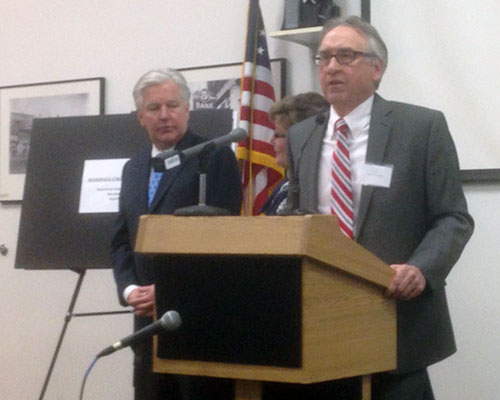Marty Meehan, left, appears with Greater Haverhill Foundation manager Ronald Trombley when UMass Lowell announced its participation in the new Harbor Place project in downtown Haverhill.
The University of Massachusetts was responsible for $6.2 billion in economic activity in Massachusetts last year – a record high – and helped to support more than 43,000 jobs statewide, President Marty Meehan said Monday.
The economic impact generated by the five-campus UMass system translates into a 10-to-1 return on investment for state government when total state funding for the University is considered, according to an analysis by the UMass Donahue Institute, which conducts economic and public policy research.
“UMass educates more students than any college or university in the Commonwealth and is one of the state’s three largest research universities, but it also has a profound impact on the Massachusetts economy based on the scope and reach of its operations,” Meehan said. “UMass is a vital economic engine for the Commonwealth,” he added, “and its impact is felt in every community and by virtually every family across Massachusetts.”
Major drivers of economic impact are student, faculty and staff spending; construction projects; and the University’s purchasing the goods and services required for its activities. The study measured spending and its “ripple effect” in determining the $6.2 billion impact estimate. UMass Lowell, which will soon have a presence in downtown Haverhill, contributed $921.9 million to the local economy, the report said.
UMass Lowell employs 1,509 regular faculty and staff and creates another 4,618 outside jobs, according to the study.
Victor Woolridge, chairman of the UMass board of trustees, said the report illustrates that “UMass truly is here for a reason, and that reason is to serve the entire Commonwealth. The importance of generating an economic impact on the scale that we do – and having it distributed in every corner of the state – cannot be overstated.”
Business community leaders described UMass as a key economic asset for the state and its regions.
“As the state’s leading association of Massachusetts employers, we are impressed by the substantial economic impact that UMass has on the Commonwealth and all of its diverse regions. Our members benefit greatly from the University’s production of talent, conduct of research, and provision of services to communities, as well as its extensive purchase of goods and services from Massachusetts businesses,” said Rick Lord, president and chief executive officer of Associated Industries of Massachusetts.


Right. Creating a nation of debt serfs can do that. Student loans are now approaching $1.4 TRILLION, while the ROI of a degree continues to plummet. In The UMass systems, that’s if they graduate at all, and in the case of my alma mater, a disgraceful graduation rate of under 60% and taking six (6) years to do so. Those who don’t, are still stuck with the debt with nothing to show for it, or years extra of full priced remedial coursework because student were never ready in the first place. Brilliant.
Mindful readers, this is for a state public institution, not some private for-profit, which years ago Marty “term limits” Meehan tried comparing the UMass schools with at a “Go Public” forum at Haverhill High School. His pal, Rep. Brian Dempsey, when questioned about the rising costs versus debt to go to a state school, his response was: “We’re working on it.” – I know, because I was the one that asked these questions. Marty of course was a little red faced, as it’s probably been a while since anyone asked him hard questions, if ever.
What could possibly be wrong when CONgress legislates private lending out of existence (2010), and uses theft, via the taxpayer, to back the student loans? These loans of course are 100% risk free for Marty and Company, as the school assume ZERO RISK, while borrowers assume all of the risk. The schools of course, since they don’t have a skin in the game, and thanks to supply and demand, can churn out debt slaves at will while reaping the risk free profits.
https://research.stlouisfed.org/fred2/graph/?g=4EBF
http://nces.ed.gov/collegenavigator/?s=all&zc=01835&zd=50&of=3&id=166513#retgrad